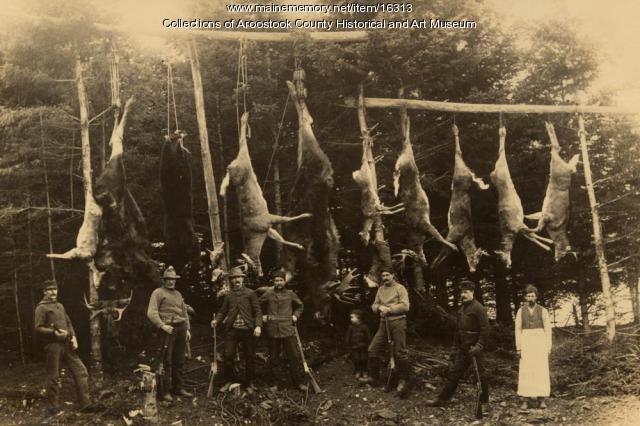Keywords: working animals
Item 36208
Dodge Street, Skowhegan, ca. 1907
Contributed by: Skowhegan History House Date: circa 1907 Location: Skowhegan Media: Photographic print
Item 61851
Theo Buswell May talks about farm life, Swan's Island, ca. 1940
Contributed by: Swan's Island Historical Society Date: circa 1940 Location: Swan's Island Media: Mp3
Item 148198
Opportunity Farm cow barn end framing, New Gloucester, ca. 1945
Contributed by: Maine Historical Society Date: circa 1945 Location: New Gloucester Client: Opportunity Farm Association Architect: University of Maine Cooperative Extension Work in Agriculture
Exhibit
Northern Threads: Colonial and 19th century fur trade
A vignette in "Northern Threads: Two centuries of dress at Maine Historical Society Part 1," this fur trade mini-exhibition discusses the environmental and economic impact of the fur trade in Maine through the 19th century.
Exhibit
Creation and other cultural tales are important to framing a culture's beliefs and values -- and passing those on. The Wabanaki -- Maliseet, Micmac, Passamaquoddy and Penobscot -- Indians of Maine and Nova Scotia tell stories of a cultural hero/creator, a giant who lived among them and who promised to return.
Site Page
Presque Isle: The Star City - Working in Maine
"Del enjoyed interacting with the animals and taking hiking trips. The other part of his job was working in the office. He did lots of paperwork."
Site Page
Home: The Wadsworth-Longfellow House and Portland - The Wadsworth Era: 1786-1807
"… in the back of the house he built a barn for the animals and equipment he needed to manage the property and support his family."
Story
My Journey: Training Service Dogs in Prison
by Anonymous (Maine State Prison)
Inmates at Maine State Prison train dogs as service and companion animals. This is one story.
Story
Why environmental advocacy is critical for making baskets
by Jennifer Sapiel Neptune
My advocacy work for the Maine Indian Basketmakers Alliance
Lesson Plan
Grade Level: 9-12
Content Area: Social Studies, Visual & Performing Arts
When European settlers began coming to the wilderness of North America, they did not have a vision that included changing their lifestyle. The plan was to set up self-contained communities where their version of European life could be lived. In the introduction to The Crucible, Arthur Miller even goes as far as saying that the Puritans believed the American forest to be the last stronghold of Satan on this Earth. When Roger Chillingworth shows up in The Scarlet Letter's second chapter, he is welcomed away from life with "the heathen folk" and into "a land where iniquity is searched out, and punished in the sight of rulers and people." In fact, as history's proven, they believed that the continent could be changed to accommodate their interests. Whether their plans were enacted in the name of God, the King, or commerce and economics, the changes always included and still do to this day - the taming of the geographic, human, and animal environments that were here beforehand.
It seems that this has always been an issue that polarizes people. Some believe that the landscape should be left intact as much as possible while others believe that the world will inevitably move on in the name of progress for the benefit of mankind. In F. Scott Fitzgerald's The Great Gatsby a book which many feel is one of the best portrayals of our American reality - the narrator, Nick Carraway, looks upon this progress with cynicism when he ends his narrative by pondering the transformation of "the fresh green breast of a new world" that the initial settlers found on the shores of the continent into a modern society that unsettlingly reminds him of something out of a "night scene by El Greco."
Philosophically, the notions of progress, civilization, and scientific advancement are not only entirely subjective, but also rest upon the belief that things are not acceptable as they are. Europeans came here hoping for a better life, and it doesn't seem like we've stopped looking. Again, to quote Fitzgerald, it's the elusive green light and the "orgiastic future" that we've always hoped to find. Our problem has always been our stoic belief system. We cannot seem to find peace in the world either as we've found it or as someone else may have envisioned it. As an example, in Miller's The Crucible, his Judge Danforth says that: "You're either for this court or against this court." He will not allow for alternative perspectives. George W. Bush, in 2002, said that: "You're either for us or against us. There is no middle ground in the war on terror." The frontier -- be it a wilderness of physical, religious, or political nature -- has always frightened Americans.
As it's portrayed in the following bits of literature and artwork, the frontier is a doomed place waiting for white, cultured, Europeans to "fix" it. Anything outside of their society is not just different, but unacceptable. The lesson plan included will introduce a few examples of 19th century portrayal of the American forest as a wilderness that people feel needs to be hesitantly looked upon. Fortunately, though, the forest seems to turn no one away. Nature likes all of its creatures, whether or not the favor is returned.
While I am not providing actual activities and daily plans, the following information can serve as a rather detailed explanation of things which can combine in any fashion you'd like as a group of lessons.













